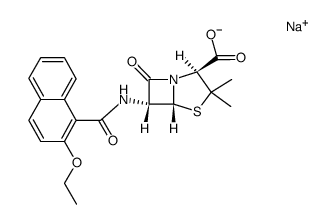Subinhibitory fluoroquinolone exposure selects for reduced beta-lactam susceptibility in methicillin-resistant Staphylococcus aureus and alterations in the SOS-mediated response.
Pierre Tattevin, Li Basuino, Henry F Chambers
文献索引:Res. Microbiol. 160(3) , 187-92, (2009)
全文:HTML全文
摘要
Growth of fluoroquinolone (FQ)-susceptible methicillin-resistant Staphylococcus aureus (MRSA) in the presence of sub-MIC FQ has been shown to enhance methicillin resistance in traditional nosocomial MRSA isolates. We aimed to confirm this phenomenon in nine community-associated MRSA (CA-MRSA) clinical isolates, and to identify candidate genes that might account for this unusual phenotype. Overnight growth of CA-MRSA strains in tryptic soy broth containing a subinhibitory concentration of either ciprofloxacin or levofloxacin resulted in a concentration-related increase in the number of colonies that grew on nafcillin agar, such that about one CFU in four exhibited significantly higher resistance to nafcillin, with only a modest increase in FQ MIC. No mutations were found in the quinolone-resistance determining region of gyrA and grlA. DNA microarray studies of a representative levofloxacin-exposed clone found that gene expression was increased for 53 open reading frames (ORFs), including norR and mecA, and decreased for 10. The majority of these ORFs encode regulatory and stress response proteins. In conclusion, sublethal exposure to FQ alters the SOS response in CA-MRSA and selects in a non-lethal manner for stable mutants with enhanced expression of methicillin resistance.
相关化合物
| 结构式 | 名称/CAS号 | 分子式 | 全部文献 |
|---|---|---|---|
 |
萘夫西林钠
CAS:985-16-0 |
C21H21N2NaO5S |
|
Clinical outcomes of a veterans affairs outpatient antimicro...
2013-06-01 [South. Med. J. 106(6) , 345-9, (2013)] |
|
β-Lactams increase the antibacterial activity of daptomycin ...
2012-12-01 [Antimicrob. Agents Chemother. 56(12) , 6192-200, (2012)] |
|
Epidemiology of community-onset Staphylococcus aureus infect...
2009-01-01 [BMC Infect. Dis. 9 , 112, (2009)] |
|
Poly(2-hydroxyethyl methacrylate-co-dodecyl methacrylate-co-...
2010-10-01 [J. Mater. Sci. Mater. Med. 21(10) , 2793-804, (2010)] |
|
Possible case of nafcillin-induced acute interstitial nephri...
2012-06-15 [Am. J. Health Syst. Pharm. 69(12) , 1049-53, (2012)] |